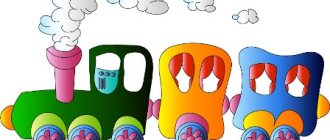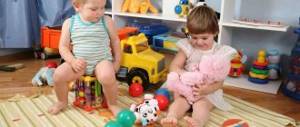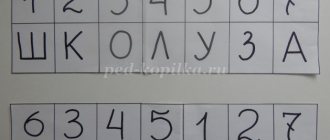Psychologist’s lesson “Magic box of memory and attention”
Home / Classes and trainings / Lesson – magic box
Correctional and developmental lesson “Magic box of memory and attention” for primary schoolchildren.
Subject. "Magic box of memory and attention"
Grade: 3-4
Number of participants: 6 people.
Lesson objectives:
- Creating conditions for a positive emotional mood in the group.
- Creating conditions for the development of students’ cognitive sphere (attention and memory) through the implementation of individual tasks.
Lesson objectives:
- contribute to the creation of a positive emotional mood in the group;
- promote the development of visual and auditory perception; attention, memory, thought processes and operations.
Equipment: computer, screen, pencils according to the number of participants, handouts for each student, emoticons to reward for correct work, mood daisies for reflection.
Progress of the lesson.
1. Organizational moment.
Hello guys. I smiled at you, and you will smile at each other. And think: how good it is that we are all here together. We are calm and kind, friendly and affectionate. Wish each other something good. Sit down. Today I will give you a developmental lesson.
2. Motivational stage.
Activities of a psychologist
- Oh, what is this on our table?
Student activities
- Children's answers - box.
Activities of a psychologist
- This is not an ordinary box. This is the “Magic Box of Memory and Attention.” It contains various tasks that will help you develop memory and attention.
— Are you ready to look into the magic box and complete tasks that are specially prepared for you?
— Today in class we will develop memory and attention. And for this you will perform various tasks and exercises.
For correctly completed tasks you will receive emoticons. At the end of the lesson we will see which of you is the most attentive.
3. Main stage.
Activities of a psychologist
Let's first check how attentive you are, how quickly and accurately you can work. - So, listen to the first task.
I will give you cards, and you count the number of numbers in them that I name. Count all the numbers “5”, “7”, “0”.
| 4 | 3 | 2 | 8 | 2 | 3 | 6 | 5 | 9 | 1 |
| 7 | 5 | 7 | 6 | 6 | 5 | 9 | 0 | 8 | 5 |
| 3 | 1 | 0 | 1 | 3 | 4 | 0 | 6 | 5 | 1 |
| 7 | 2 | 4 | 1 | 0 | 6 | 2 | 3 | 7 | 1 |
| 6 | 5 | 4 | 4 | 3 | 8 | 8 | 3 | 1 | 3 |
| 8 | 0 | 0 | 3 | 2 | 1 | 5 | 4 | 9 | 5 |
| 0 | 7 | 6 | 3 | 2 | 6 | 3 | 8 | 2 | 9 |
| 6 | 1 | 7 | 6 | 9 | 5 | 8 | 5 | 9 | 0 |
| 7 | 4 | 1 | 7 | 5 | 3 | 9 | 2 | 3 | 4 |
| 6 | 3 | 0 | 7 | 6 | 9 | 1 | 0 | 9 | 1 |
Student activities
Working with a table. Reflection. -Well, is it difficult? Children's answers. Who completed the task without errors, raise your hand. Presentation of emoticons.
Activities of a psychologist
As you can see, if you work quickly, you can make a lot of mistakes, and if you work slowly, you waste a lot of time. And we will try to work out your attention so that it is correct and fast. And to do this, let’s complete the next task from the box for attention, which is called “I won’t get lost.”
Purpose of the exercise: develop concentration and eliminate attention distribution disorder. Listen carefully to the task. The student should count to 31, saying everything out loud, but he should not say numbers that contain three or are multiples of three. Instead, he should say the phrase “I WILL NOT GET MISTAKED.” For example: 1, 2, I won’t get lost, 4, 5, I won’t get lost, etc.
Student activities
Perform the exercise by all students in turn. Reflection. — Was it easy to complete this task? Children's answers. — What difficulties did you experience while completing this task? Presentation of emoticons. Activities of a psychologist - Now let's test your memory. So listen to the next task. Using it, we will find out how developed your memory is. - Listen and write the words you hear in any order for 2 minutes. Words: Dog, Boy, River, Wind, Parrot, Jug, Water, Sky, Saw, Bird, Girl, Tree, Music, Mushroom, Carpet.
- If you have written 10-15 words, then you have a wonderful memory. - If you have written 6-10 words, you have a good memory.
If less than 5 words, you need to train your memory.
Student activities
Write down the words on pieces of paper that you remember. Activities of a psychologist - Who completed the task and how?
Student activities
Student answers. Presentation of emoticons. Activities of a psychologist As you can see, the results are not very good. But you will have to read a lot of texts, poems, and memorize them. If you do not develop your memory and attention, you will have to spend a lot of time preparing lessons and repeating.
- What is the best way to remember? Learn to be more attentive? You just need to constantly work, train your memory and attention.
To do this, you will complete the last task from the magic box, “Fun Tables”.
Goal: development of visual attention and memory.
Now I will give you a table of 9 cells with various objects depicted in them, and your task is to remember these objects. Then you remove this table, and I will provide you with a table of 16 cells also with images of various objects, among which are the previous images. Your task is to write down the items that were in the previous table.
Student activities
Student activities
Reflection. —Who had any difficulties and what? - Who managed to cope without mistakes? Student activities Student responses. Awarding emoticons for work done correctly. Counting emoticons. Identifying the most attentive student during a lesson.
4. Summary of the lesson.
Please tell me, what have we learned today? Do you think it’s worth training your memory and attention? Was our lesson useful for you?
Student activities
Students' answers.
5. Reflection.
On the table in front of you are daisies with different moods; pick up and show the daisy that reflects your mood after our lesson. - Thanks for the lesson!
Applications.
Teacher-psychologist MBOU Krasnovskaya secondary school 2020: Galat Oksana Anatolyevna
Correctional and developmental lesson 3rd grade
Correctional and developmental lesson 3rd grade
Purpose of the lesson: creating conditions for the development of the cognitive sphere of students through the implementation of individual tasks.
Lesson objectives:
- Development of verbal-logical and visual-figurative thinking.
- Development of visual and auditory perception; attention, memory, speech of students.
- Formation of elements of self-control.
- Prevention of deviation in behavior.
Forms of organizing classes:
- group;
- work in pairs;
- individual.
Methods of organizing classes :
- Educational and educational games for the development of attention, memory, and thinking.
- Conversation, dialogue.
- Questioning.
Form of the lesson:
- Practical training (practical lesson).
- Interactive forms (game exercises).
Type of lesson: application of knowledge in practice, development of practical skills.
Expected results:
- development of cognitive processes (thinking, memory, attention, speech of students);
- increasing the efficiency and activity of group cooperation among students;
- development of self-control;
- formation of a positive attitude of students towards the educational process.
Performance indicators:
- analysis of the results of completed tasks;
- degree of activity of students in class;
- ability to listen and engage in dialogue;
- emotional mood of students.
Participants : 2nd grade students.
Equipment: presentation, ball, A-4 paper, colored pencils.
- Introductory part
Hello guys. I am glad to welcome you to our lesson. Today we will perform a lot of interesting tasks, but more on that later. Now I suggest you play a game called “Ball”. Everyone stand in a circle.
- Exercise "Ball"
Purpose: greeting, exchange of positive emotions, uplifting mood.
Time: 3 minutes.
Conduct: Children stand in a circle. The speech pathologist gives a task to the children: in turn, everyone must throw a ball to each other with the words “I’m glad to see you again (name is called).” The ball should be in the hands of every child. The defectologist starts with himself.
Defectologist: So, we can say that we are all happy to see each other in our lesson. Now let's give our smiles to each other, to me and to our guests! Take your seats.
II . Main part
2.1 Clarify goals, expectations and concerns. Exercise “Warm Hearts” .
Guys, you are all familiar with Dunno. He always finds himself in different situations. And now Dunno has climbed into Znayka’s book. Looking for an answer to the question: “What do you need to do in order to become smart?”
- What do you think you will answer him?
— Znayka also advised him that he needs to learn to train his attention, memory, learn correctly, reason, think logically. Let's teach Dunno, because today in class we will be training our memory, attention, and thinking. And in gratitude for your help, he promised to give you his portrait as a souvenir.
So, let's start with a warm-up.
Warm-up “What does a person have?”
- A bird has a wing, and a person has ... (hand)
- The beast has a paw, and the man has ... (leg)
- The candy has a candy wrapper, and the person has ... (skin, clothes)
- A lion has a mouth - and a man has ... (mouth)
- A car has a motor, but a person has ... (heart)
Defectologist: Well done, while we were doing the warm-up, Dunno found in the book the first task that Znayka had prepared for him.
It's called "Restore Order"
2.1. Exercise “Restore Order”
Goal: development of verbal and logical thinking,
Instructions : You must place all tasks in the correct order and sign the numbers. The work is carried out individually.
| Put the time of day in the correct order (write the numbers). Day evening morning night () () () () Put the seasons in the correct order (write the numbers). Spring autumn winter summer () () () () Put the days of the week in the correct order (write the numbers). Wednesday Monday Tuesday Thursday ( ) ( ) ( ) ( ) |
Defectologist: Well done, you all did a good job with this task.
Reflection: Was it difficult for you to put all the tasks in the correct order? Why do you think? (Correct - because you know the seasons, days of the week, parts of the day). Meanwhile, Dunno saw the second task in the book, which is called “Halves of Words.”
2.2. Exercise "Halves of words."
Goal : development of verbal-logical and visual-figurative thinking.
Instructions: You must connect halves of words to form whole words.
| shlya | ka | bee | sha |
| tuff | on | behind | ka |
| ut | whether | gru | yats |
| weight | pa | mis | la |
Defectologist : Well done guys, I’m very glad that everyone got complete words.
Reflection: Tell me, what difficulties did you encounter when completing this task? Fine. And our Dunno faced another problem. He needs to find the words hidden behind the numbers. Shall we help him?
2.3. Exercise " Cryptographer"
Goal: development of concentration and thinking
Instructions: Using the code, you need to find the words hidden behind these numbers. The task is completed individually.
| m | O | P | A | l | To | With | n | at | With |
| 1 | 2 | 3 | 4 | 5 | 6 | 7 | 8 | 9 | 10 |
Example: 1, 4, 1, 4 – ... m a m a
3, 4, 3, 4 - ... p a p a
10, 9, 3 - ... s y p
8, 2, 7 — … nose
5, 9, 6 - ... l u k
5, 4, 6 - ... lak
Defectologist: Well done guys, you did this task well too.
Defectologist: I think you’re tired and it’s time for us to do a little physical education.
We rested and gained new strength. They will be very useful to us, since Dunno saw task 4 and does not know how to cope with it. And the task is called “Remember.”
2.4 Exercise “Remember”
Goal: development of figurative memory.
Instructions: within 30 seconds you need to remember and then draw everything you remember.
Questions for memorization : I want you to once again remind Dunno what was drawn in our picture so that he remembers everything better.
- How many chickens were there in the picture (2).
- How many birds were there (2).
- How many ants were there (1).
- How many butterflies were there (1).
- How many mushrooms were there (2).
- How many stumps were there (3).
- How many snails were there (1).
- What else was in the picture (sun, flowers, grass, earth).
Defectologist : Well done. I think we helped Dunno remember what he had drawn. You agree with me? Meanwhile, Dunno saw new task No. 5. And he already managed to complete it, began to draw the pattern, was constantly distracted, and as a result, he got it right and then wrong. We need to find errors and correct them.
2.5. Exercise “Where did Dunno go wrong?”
Goal: development of attention, perseverance
Instructions: Find errors and correct them.
Defectologist : Well done, everyone coped well with the task. But that’s not all Dunno saw the last task No. 6. And it’s called “Spatial Dictation.”
2.6. Exercise “Spatial dictation”
Goal : development of graphic skills, spatial orientation, visual motor coordination
Instructions: You need to draw geometric shapes on a sheet of paper, following dictation. We listen and complete tasks carefully, without distractions.
After the dictation is completed, the correctness of the layout is controlled using a sample that is prepared in advance, or by repeating the text of the instructions step by step.
Tasks:
- draw a red square in the center of the sheet
- to the right of the red square draw a blue square
- Draw a blue triangle on top of the blue square
- Draw a green triangle below the red square.
- Write the letter O
- To the right of it write the letter K
- To the left of the letter O, write the letter C.
- What word did you get? (JUICE)
Defectologist: And now your neighbor will evaluate how correctly you completed the “Spatial Dictation”. Well done!
- Final part
3.1. Reflection
Summing up the lesson. Well done boys. Do you think we helped answer the dunno’s question “What do you need to do in order to become smart?”
- Remind me again, “What do you need to do to become smart?”
- Did you like helping Dunno?
- What did you like most?
- What was difficult about the lesson?
Defectologist: Guys, you have self-adhesive stickers on your tables. You must choose for yourself
Instructions: “Assess your mood”
- Green color - I'm in a great mood
- Yellow color - I'm in a good mood
- Red color - I'm in a bad mood
- Do you think we achieved the goal of our lesson? (trained your memory, attention, thinking).
- What have you learned? (Yes, we really learned...) (trained our memory, attention, thinking)
Formed UUD:
- Personal:
- development of cognitive interests.
The means to achieve these results are: tasks that develop mental processes, the development of self-knowledge.
Meta-subject results are the formation of UUD.
- Regulatory:
- determine and formulate the goal of activity in class with the help of a psychologist;
- pronounce the sequence of actions in class;
- learn to express your assumption;
- learn to work according to the plan proposed by the psychologist.
The means of formation is the technology of psychological self-regulation.
- Cognitive:
- be able to find answers to questions;
- draw conclusions as a result of joint work between students and a psychologist.
The means of formation are logical, problem-based tasks.
- Communicative:
- express your thoughts orally and in writing;
- listen and understand the speech of others;
- learn to work in a group.
The means of formation are productive interaction and cooperation with peers and a psychologist; be able to listen and engage in dialogue, participate in collective problem solving.
Correctional and developmental lesson 3rd grade
FORM F.I.__________________________________________Class__________
Exercise No. 1 “Restore order”
Exercise No. 2 “Halves of words.”
Instructions:
You must connect halves of words to form whole words.
| shlya | ka | bee | sha |
| tuff | on | behind | ka |
| ut | whether | gru | yats |
| weight | pa | mis | la |
Exercise No. 3 “Cryptographer”
Instructions:
Using the code, find the words hidden behind these numbers.
| m | O | P | A | l | To | With | n | at | With |
| 1 | 2 | 3 | 4 | 5 | 6 | 7 | 8 | 9 | 10 |
1, 4, 1, 4 — ________________
3, 4, 3, 4 — ________________
10, 9, 3 — _________________
8, 2, 7 — _________________
5, 9, 6 — __________________
5, 4, 6 — ___________________
Exercise No. 4 “Remember”
Instructions: within 30 seconds you need to remember and then draw everything you remember.
Exercise No. 5 “Where did Dunno go wrong?”
Instructions: Find errors and correct them.
Exercise No. 6 “Spatial dictation”
Instructions: Draw geometric shapes from dictation.
Training for children 5-6 years old “The Art of Communication”
Goal: bringing children together emotionally and improving the ability to openly express their feelings, the ability to say kind words and wishes, as well as the ability to show empathy.
Materials: magic wand, butterfly, tape recorder, sheets of paper with images of blots.
Progress of the lesson.
Psychologist: Hello guys! I'm very glad to see you all. Now we will greet each other. But we will greet not with words, but with our hands. Close your eyes. I will touch the one sitting to my right. He will accept my greeting and pass it on to his neighbor in the same way - he will touch him. And so on, until my greeting comes back to me again, only from the other side. Amazing! And now we will play the game “Praise your neighbor.”
Children: Each child praises his neighbor on the right, the last one praises the psychologist.
Psychologist: Well done guys! You tried very hard to praise your neighbor, and for this I, with the help of this magic wand, will take you to the ball, where there are many butterflies, dragonflies, beetles, mosquitoes and other insects.
(The psychologist waves his magic wand and the children are transported to a fairyland to the sound of magical music.)
Psychologist: Oh guys! And who is this lying on our earth?
Children: It's a butterfly!
Psychologist: Yes, it really is a butterfly. But why doesn't she fly? Let's go up to her and see if she needs our help. (Children together with a psychologist approach the butterfly, the psychologist takes it in his hands). Guys, her wing is broken. Let's help her. Let each of you tell her your wish. (Children pass the butterfly to each other and express their wishes).
Psychologist: Well, guys, look, you cured the butterfly and now it can fly. (The psychologist lets go of the thread and shows the children how a butterfly flies). Now guys, close your eyes and imagine that you have turned into the same beautiful butterflies. (Music plays, children begin to move around the room pretending to fly butterflies. The music fades out)
Psychologist: Guys, while you were depicting the flight of a butterfly, my magic wand moved us to the country of “Klyasography”. Look, the blots are lazy and don’t want to do anything. Let's help them. (Sheets of paper with images of blots lie on the carpet). Choose any blot and turn it into something interesting. (Music plays, to the sound of which the children complete the details so that the blot becomes a character. At the end of the work, everyone examines the drawings, the psychologist praises the children.)
Psychologist: Well done guys! But it’s time for you and me to return to kindergarten. (Children sit in their seats. Close their eyes and, to the music, the magic wand returns them home.)
Psychologist: Guys, you liked our trip.
Children: Yes!
Psychologist: What did you like most about fairyland?
Children: give their own answers.
Psychologist: Our lesson is coming to an end. I thank you all. It was a pleasure to work with you. And now we will pass each other a magic wand and say which magical country you would like to go to next time.






